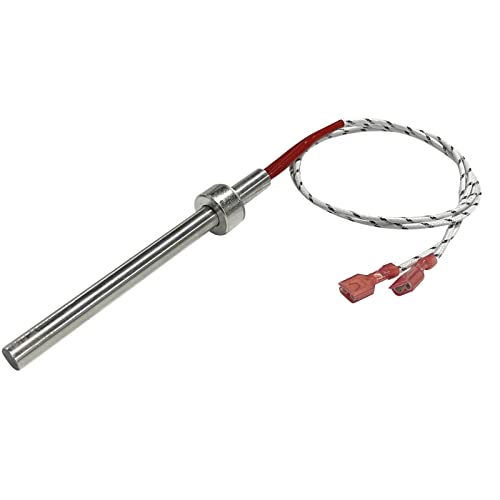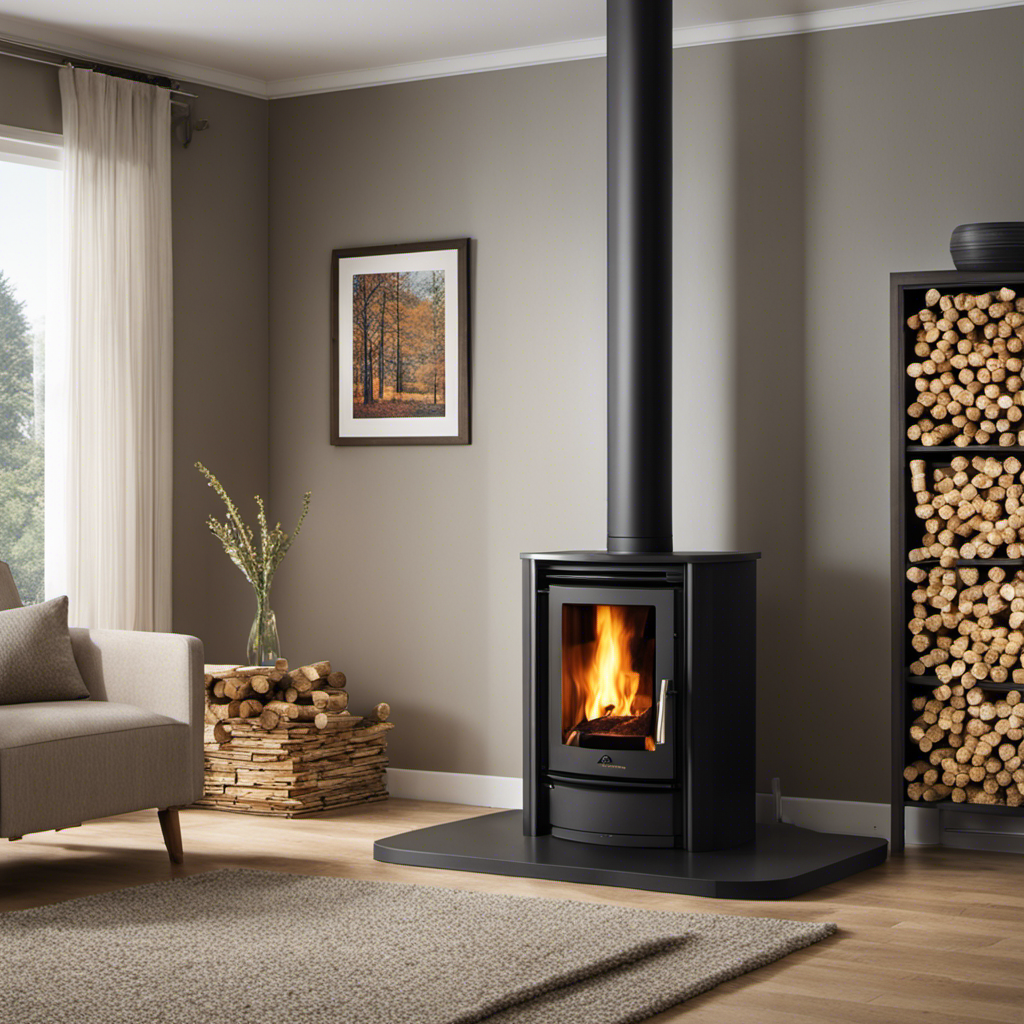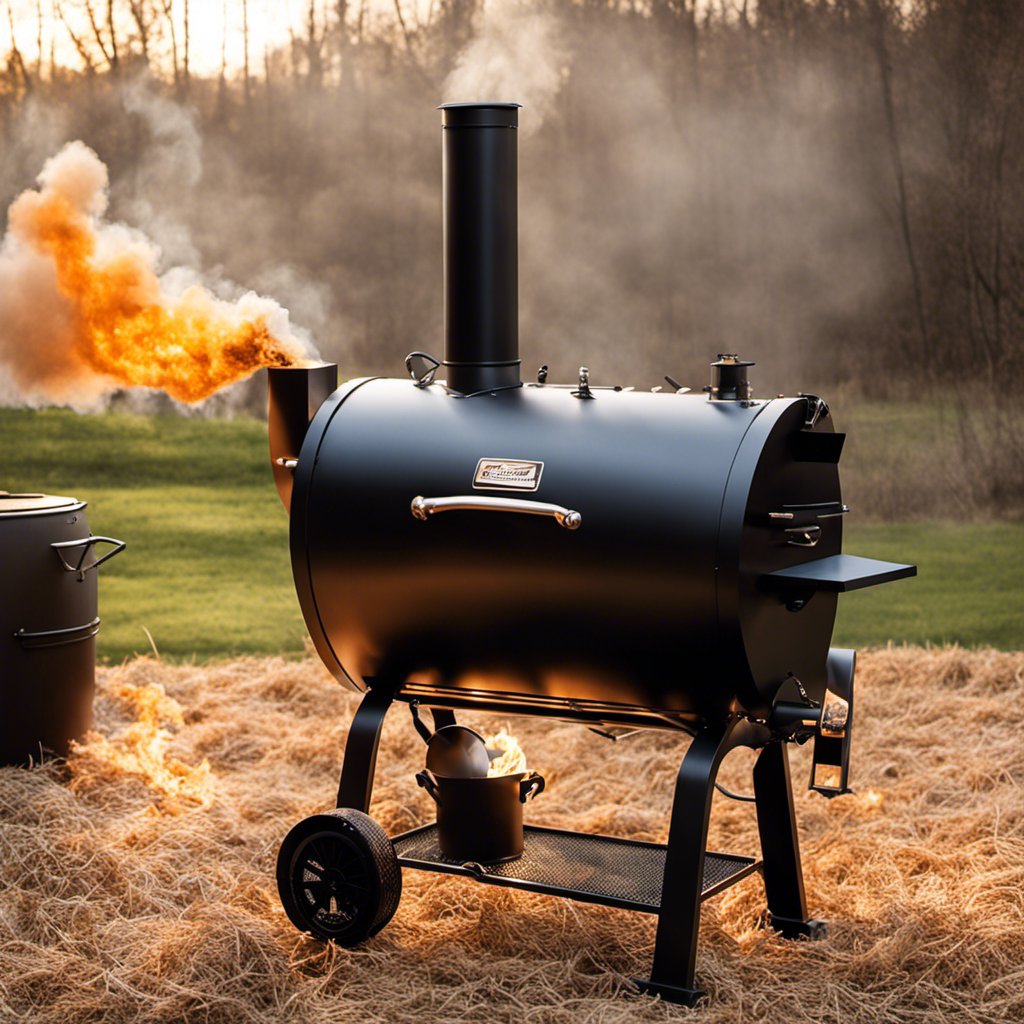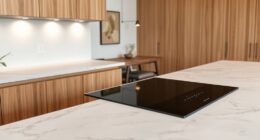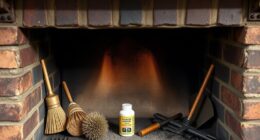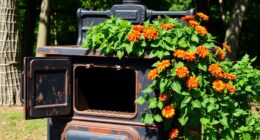This article will delve into the indicators and hazards of leaking pellet stoves, along with strategies for detecting and repairing these leaks.
We understand the importance of maintaining a safe and efficient heating system in our homes. Leaking pellet stoves can pose serious risks, such as carbon monoxide poisoning, and compromise the stove’s longevity.
By identifying the signs and taking proactive measures, we can ensure the safety of our households. Join us as we delve into the world of leaking pellet stoves and find the fixes to keep our homes warm and secure.
Key Takeaways
- Signs of pellet stove leaks include soot leaking through holes, strong smell of smoke, trails of soot from vents, and light shining through the stove.
- Pellet stove leaks can lead to severe CO2 poisoning as CO2 gases are released along with soot.
- Regular maintenance is important to prevent leaks and ensure safety, including inspecting and maintaining seals, cleaning the stove, and checking for hidden holes.
- Pellet stoves offer benefits such as high energy efficiency, environmentally friendly fuel source, cost-effectiveness, and consistent heat distribution.
Signs of Soot Leakage
We noticed trails of soot from the vents, indicating possible leakage in the pellet stove. Soot leaking through holes in the stove is a sign of potential danger. It’s crucial to address this issue promptly to prevent CO2 poisoning and ensure the safety of everyone in the room.
CO2 gases are released along with the soot, and they’re odorless, colorless, and dangerous. To prevent CO2 poisoning, regular maintenance is essential. Thoroughly test the pellet stove system before use and inspect and maintain seals at connection points. Clean the stove to reveal any hidden holes and use properly rated duct tape to seal vents.
Regular cleaning and inspection of the stove will help identify and fix any leaks, ensuring the longevity of the stove and preventing potential CO2 poisoning.
Strong Smell of Smoke
When we smell a strong odor of smoke in the room, it’s a clear indication that something is wrong with the pellet stove. This smell can be quite unpleasant and can also be a sign of potential dangers.
To prevent smoke odor and address ventilation issues, here are four important steps to take:
-
Check the air intake: Ensure that the air intake isn’t blocked by any debris or obstructions. A blocked intake can lead to poor combustion and an increase in smoke production.
-
Clean the exhaust system: Regularly clean the exhaust system, including the chimney and vent pipes, to prevent the buildup of soot and other residues. A clean exhaust system allows for proper airflow and reduces the chances of smoke entering the room.
-
Inspect and maintain seals: Check the seals around the pellet stove and its components. Any gaps or leaks can contribute to smoke odor. Replace any deteriorated seals to ensure proper ventilation.
-
Install carbon monoxide detectors: Carbon monoxide (CO) is a silent and deadly gas that can be emitted from a malfunctioning pellet stove. Install CO detectors near the stove and regularly test them to ensure your safety.
Trails of Soot From Vents
Trails of soot from the vents indicate a potential issue with the ventilation system of our pellet stove. Soot accumulation can lead to decreased efficiency and potential safety hazards.
To prevent soot accumulation and ensure proper functioning, it’s crucial to regularly clean and maintain the venting system. Start by inspecting the vents for any blockages or obstructions. Clear any debris or build-up that may be hindering the airflow.
Check for any leaks or gaps in the venting system and seal them using high-quality duct tape. Additionally, consider scheduling professional maintenance to thoroughly clean and repair the venting system.
Light Test for Leaks
The light test will help identify any leaks in the venting system of our pellet stove. Here’s how you can conduct the test:
- Turn off the pellet stove and allow it to cool down completely.
- Close all doors and windows in the room to create a draft-free environment.
- Turn off any fans or ventilation systems that may interfere with the test.
- With the room pitch black, shine a bright flashlight along the entire length of the venting system, including the joints and connections.
Dangers of CO2 Poisoning
We need to be aware of the potential hazards of CO2 poisoning when using our pellet stove. CO2, also known as carbon dioxide, is a colorless and odorless gas that can be released along with soot from the stove. This gas can accumulate in closed spaces and pose a serious health risk.
To prevent CO2 poisoning, it’s essential to install CO2 detectors in our homes. These detectors will alert us if the CO2 levels reach dangerous levels, allowing us to take immediate action. Installing CO2 detectors is a crucial step in ensuring the safety of ourselves and our loved ones when using a pellet stove.
Importance of CO2 Detectors
CO2 detectors are crucial for our safety, as they alert us to the presence of this odorless and dangerous gas. Here are four reasons why CO2 detectors are important and why regular maintenance is essential:
-
Early detection: CO2 detectors provide an early warning system, allowing us to take immediate action and prevent potential harm. They can detect even low levels of CO2, ensuring our safety.
-
Peace of mind: Knowing that we have a CO2 detector installed and properly maintained gives us peace of mind. We can have confidence in our safety and the well-being of our loved ones.
-
Preventing CO2 poisoning: Regular maintenance of CO2 detectors ensures that they are functioning properly and accurately detecting CO2 levels. This helps prevent CO2 poisoning, which can lead to serious health issues and even death.
-
Longevity: Regular maintenance of CO2 detectors extends their lifespan and ensures their effectiveness. By replacing batteries, testing the alarms, and keeping them clean, we can ensure that they will continue to protect us for years to come.
CO2 Build-up in Small Rooms
Now let’s discuss the dangers of CO2 build-up in small rooms and how to prevent it.
In confined spaces, such as small rooms, CO2 build-up can pose serious risks to our health and safety. CO2, or carbon dioxide, is an odorless and colorless gas that can accumulate when there’s inadequate ventilation. Breathing in high levels of CO2 can cause dizziness, headaches, difficulty breathing, and in extreme cases, it can even be life-threatening.
To prevent CO2 build-up in small rooms, it’s crucial to ensure proper ventilation by opening windows or using fans to circulate fresh air. Additionally, installing CO2 detectors can provide an early warning system and allow us to take necessary actions to prevent harm.
It’s essential to prioritize safety and take proactive measures to avoid the dangers associated with CO2 build-up in confined spaces.
Methods to Find Leaks
When identifying leaks in our pellet stove system, it’s important to thoroughly test and inspect all connection points and seals. Regular maintenance and proper cleaning procedures are crucial to keep our pellet stoves in good working condition.
Here are four steps to find and fix pellet stove leaks:
-
Conduct a thorough test of the entire pellet stove system before use.
-
Check for any spots where the system is welded or taped sealed and ensure they’re intact.
-
Inspect and maintain the seals at all connection points to prevent any leaks.
-
Clean the stove regularly to reveal any hidden holes or leaks that may be present.
Checking Welded or Taped Seals
Inspecting the integrity of welded or taped seals is an important step in ensuring the safety and efficiency of our pellet stove system. Properly maintained seals are crucial for preventing leaks and potential dangers. To help you understand the significance of checking maintenance and safety precautions, we have provided a table outlining the key steps involved in inspecting and maintaining these seals.
| Step | Description | Safety Precautions |
|---|---|---|
| 1 | Visually inspect all welded or taped seals for any signs of damage or deterioration. | Wear protective gloves and eyewear to avoid injury. |
| 2 | Test the seals by running the pellet stove and checking for any visible leaks or irregularities in the seal’s appearance. | Ensure proper ventilation in the room to prevent the build-up of harmful gases. |
| 3 | If any leaks or issues are found, promptly repair or replace the damaged seals to maintain the stove’s efficiency and safety. | Follow the manufacturer’s guidelines for seal replacement and use appropriate tools and materials. |
Inspecting Connection Point Seals
By regularly checking the integrity of our connection point seals, we can ensure the safety and efficiency of our pellet stove system. Inspecting seal integrity is crucial as it helps us identify any potential issues and prevent leaks.
Common causes of seal deterioration include:
-
Age and wear: Over time, seals can deteriorate due to constant use and exposure to heat and other elements. Regular inspection allows us to identify any signs of wear and tear.
-
Improper installation: If the seals weren’t installed correctly initially, they may deteriorate faster or fail to provide a proper seal. Regular inspection helps us catch any installation errors and rectify them promptly.
-
Maintenance neglect: Lack of proper maintenance, such as cleaning and lubrication, can lead to seal deterioration. Regular inspection reminds us to perform the necessary maintenance tasks to prolong the life of the seals.
-
Environmental factors: Factors like extreme temperatures, humidity, and exposure to chemicals can degrade seals over time. Regular inspection helps us identify any environmental factors that may be impacting the seals and take appropriate measures to mitigate them.
Cleaning to Reveal Hidden Holes
Regularly cleaning our pellet stove system allows us to reveal any hidden holes and address potential issues to maintain the stove’s efficiency and safety.
Cleaning techniques are essential in preventing future leaks and ensuring optimal performance.
When cleaning the stove, it’s important to pay attention to the venting system and internal components. A thorough inspection using a bright flashlight can help identify any leaks or gaps in the seals.
Properly rated duct tape can be used to seal vents and prevent air leakage.
Additionally, cleaning the stove’s interior can help identify any internal leaks that may be causing issues.
Identifying Leaks With a Flashlight
When it comes to preventing pellet stove leaks, one effective technique is using a flashlight to identify any potential leaks in the venting system. Here are four key steps to successfully utilize the flashlight technique:
-
Prepare the flashlight: Ensure that you’ve a bright flashlight with fresh batteries. A high-intensity LED flashlight works best for this task.
-
Darken the room: Turn off any lights in the room where the pellet stove is located. This will create a darker environment, making it easier to spot any leaks.
-
Shine the flashlight: With the pellet stove running, shine the flashlight along the venting system, paying close attention to the joints and connection points. Look for any areas where light shines through, indicating a potential leak.
-
Seal any leaks: Once you’ve identified a leak, use properly rated duct tape to seal the area. This will prevent any further leakage and ensure the stove operates efficiently.
Properly Sealing Vents With Duct Tape
Sealing vents with duct tape ensures that the pellet stove operates efficiently and prevents any potential hazards. Proper vent sealing techniques are crucial for maintaining the performance and safety of a pellet stove.
In addition to duct tape, there are alternative methods for vent sealing that can be considered. One option is using high-temperature silicone caulk to seal the gaps and joints in the venting system. This provides a durable and long-lasting seal.
Another alternative method is using metal foil tape, which is specifically designed for HVAC applications. It adheres well to metal surfaces and provides a tight seal.
Whichever method is chosen, it’s important to ensure that the sealing is done properly, with attention to detail. This helps to prevent any leaks or drafts, ensuring that the pellet stove operates at its optimum efficiency while minimizing any potential safety risks.
Regularly Checking and Replacing Seals
We should prioritize checking and replacing seals on a regular basis to ensure the proper functioning and safety of our pellet stove. Here are four important reasons why checking and replacing worn seals should be a part of our maintenance schedule:
-
Preventing leaks: Worn seals can lead to leaks, allowing soot and smoke to escape into our living spaces. Regularly checking and replacing seals will help prevent these leaks, keeping our home clean and safe.
-
Ensuring efficiency: Properly sealed seals help maintain the efficiency of our pellet stove. By preventing air leakage, the stove can burn pellets more efficiently, providing effective heat without wasting energy.
-
Extending lifespan: Regular maintenance, including checking and replacing seals, can extend the lifespan of our pellet stove. By addressing any seal issues promptly, we can avoid further damage to the stove, ensuring its longevity.
-
Safety: Worn seals can pose safety hazards, such as the risk of carbon monoxide poisoning. By regularly checking and replacing seals, we can ensure that our pellet stove operates safely and protects our health and well-being.
Cleaning to Identify Internal Leaks
Now that we’ve discussed the importance of regularly checking and replacing seals in pellet stoves, let’s move on to the next step in pellet stove maintenance: cleaning to identify internal leaks.
Cleaning the stove not only helps to maintain its overall performance but also allows us to identify any hidden holes or leaks that may be present.
To begin the cleaning process, it’s important to turn off the stove and allow it to cool down completely. Once cooled, we can remove the ash and debris from the burn pot, ash pan, and any other accessible areas. This will help us get a clear view of the stove’s interior.
Next, we can use a bright flashlight to carefully inspect the venting system, including the flue pipe and any joints or connections. Any leaks or holes will be visible as light shining through. It’s important to seal any leaks we find using properly rated duct tape or other appropriate materials.
Are Leaking Pellet Stoves Often Caused by Auger Troubles?
Leaking pellet stoves can sometimes be caused by auger troubles. Proper troubleshooting pellet stove augers can identify issues with the feed mechanism that may result in leaks. Regular maintenance and timely repairs can prevent potential problems with pellet stove augers and keep the stove running efficiently.
How Can Pellet Stove Auger Issues Cause Leaks and What Are the Fixes?
Troubleshooting pellet stove augers is crucial in preventing leaks. If the auger jams, excess fuel accumulates, leading to overloading and potential leaks. To fix this issue, check for obstructions and clean the auger if necessary. Also, ensure proper alignment and tension adjustment for smooth operation. Regular maintenance and prompt attention to auger problems can significantly reduce the risk of leaks.
Frequently Asked Questions
How Often Should I Test My Pellet Stove System for Leaks Before Use?
We should regularly test our pellet stove system for leaks before use to ensure safety and optimal performance. The testing frequency may vary depending on factors such as the age and condition of the stove. However, it’s generally recommended to test the system at least once a year.
Regular testing allows us to identify any potential leaks early on and take necessary actions to fix them. By addressing leaks promptly, we can prevent the dangers associated with pellet stove leaks and ensure the longevity of our stove.
What Should I Do if I Notice Streaks of Soot on My Older Pellet Stove?
If we notice streaks of soot on our older pellet stove, there are a few steps we can take to address the issue.
Firstly, we should clean the stove thoroughly to remove any build-up and reveal hidden holes.
Secondly, we can inspect and replace any deteriorated seals that may be causing the leaks.
Regular maintenance is crucial in preventing leaks and ensuring the safety and longevity of the stove.
Can a Pellet Stove Leak Lead to CO2 Poisoning Even if There Is No Visible Soot?
Yes, a pellet stove leak can potentially lead to CO2 poisoning, even if there’s no visible soot. CO2 gases are released along with the soot, and CO2 is odorless, colorless, and dangerous.
This poses a serious health risk, especially in small rooms where CO2 build-up from breathing can occur. It’s essential to have CO2 detectors installed for safety.
Common causes of pellet stove leaks include deteriorated seals, holes in the stove, and improper maintenance. Regular maintenance is crucial to prevent leaks and ensure safety.
Is It Necessary to Use a Bright Flashlight to Identify Leaks in the Venting System?
Using a bright flashlight to identify leaks in the venting system isn’t necessary, but it’s highly recommended. There are alternative methods, such as using a strong light source, but a bright flashlight provides the best visibility. It helps to pinpoint even the tiniest leaks that may not be visible to the naked eye.
Common causes of pellet stove leaks include deteriorated seals, improper maintenance, and soot build-up. Identifying and fixing these leaks is crucial for the safe and efficient operation of the pellet stove.
How Frequently Should I Check and Replace Deteriorated Seals on My Pellet Stove?
When it comes to regular maintenance for pellet stoves, checking and replacing deteriorated seals is crucial. By inspecting the seals on a routine basis, we can ensure the stove’s safety and prevent potential leaks.
Regular maintenance not only extends the lifespan of the pellet stove but also maintains its overall quality. By staying on top of seal replacements, we can avoid the dangers of leaking pellet stoves and enjoy the benefits of a well-maintained and efficient heating option.
Conclusion
In conclusion, it’s crucial to be aware of the signs and dangers of leaking pellet stoves in order to maintain a safe and efficient heating system. By identifying and fixing these leaks, we can prevent the risks of carbon monoxide poisoning and ensure the longevity of our pellet stoves.
Regular maintenance and proper sealing of vents are key in addressing and preventing leaks. Remember, a small leak can lead to big consequences, so stay vigilant and keep your home warm and secure.
Embrace the warmth, but do so safely.



